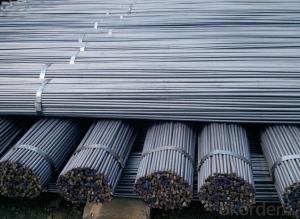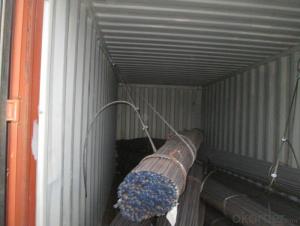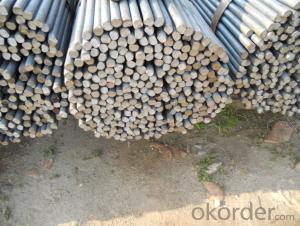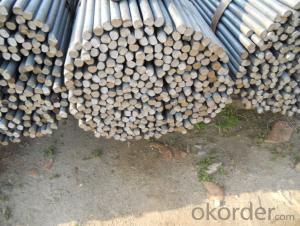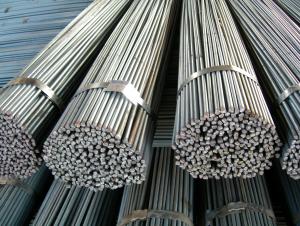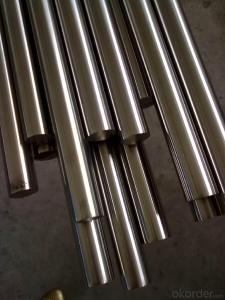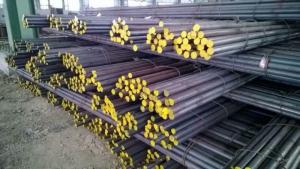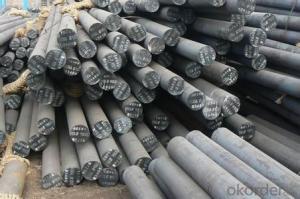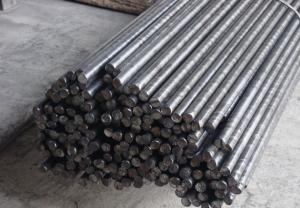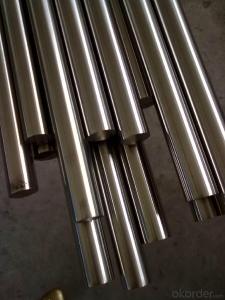Steel Round Bar Product Heat treatment of high quality steel
- Loading Port:
- Tianjin
- Payment Terms:
- TT or LC
- Min Order Qty:
- 25 m.t.
- Supply Capability:
- 7000 m.t./month
OKorder Service Pledge
OKorder Financial Service
You Might Also Like
Specification
OKorder is offering Steel Round Bar Product Heat treatment of high quality steel with worldwide shipping. Our supplier is a world-class manufacturer of steel, with our products utilized the world over. OKorder annually supplies products to European, North American and Asian markets. We provide quotations within 24 hours of receiving an inquiry and guarantee competitive prices.
Product Applications:
Steel Round Bar Product Heat treatment of high quality steel are ideal for structural applications and are widely used in the construction of buildings and bridges, and the manufacturing, petrochemical, and transportation industries.
Product Advantages:
OKorder's Steel Round Bar Product Heat treatment of high quality steel are durable, strong, and resist corrosion.
Main Product Features:
· Premium quality
· Prompt delivery & seaworthy packing (30 days after receiving deposit)
· Corrosion resistance
· Can be recycled and reused
· Mill test certification
· Professional Service
· Competitive pricing
Product Description:
Specifications of Common Steel Round Bar
1. Grade: 304, 316L, 321
2. Type: Mild carbon steel
3. Shape: Round bar, solid bar of steel with circular section
4. Diameter: 8mm-150mm
5. HS Code: 72283010
Usage and Applications of Common Steel Round Bar
1. Common Steel Round Bar of 8-25mm, or small round is mostly used for straight bundles supply, and used for steel, bolts and various mechanical parts. While the bigger round bar, or more than 25mm hot rolled bar, is mainly for the manufacture of mechanical parts or for seamless steel billet.
2. Steel round bar is used in construction and a large number of architectural and engineering structures.
3. Besides, we can supply some especial material steel round bar that can be used for main shaft of steamer, hummer shank, with big section and supper force.
Packaging & Delivery of Common Steel Round Bar
Packaging Detail: All goods are packed in bundle with steel strips and shipped by break bulk vessel or container (depend on target market and different ports)
Delivery Detail: 45 days
Trade terms: FOB, CFR, CIF
MOQ: 25 tons per specification; we can negotiate the quantity if the specification is normal or we have stock of one specification.
Weight: The price invoicing on theoretical weight basis or actual weight basis depends on customer’s request.
Shipment: The shipment of bulk break or container is depends on customer’s request and the situation of the port of destination.
Documents given: Full set of original clean on board bill of lading; Original signed commercial invoice; Original packing list; Policy of insurance; Certificate of origin and what the target market needs.
Production Flow of Common Steel Round Bar
We use advanced equipments like Electric Arc Furnace, Ladle Furnace and Vacuum Degasser to produce our products.
Material prepare (billet) — heat up — rough rolling — precision rolling — cooling — packing — storage and transportation
Characteristics of Common Steel Round Bar
1. The steel in which the main interstitial alloying constituent is carbon in the range of 0.12–2.0%.
2. As the carbon percentage content rises, steel has the ability to become harder and stronger through heat treating; however it becomes less ductile.
3. Quality should be in conformity with the specification of the manufacturer. Quantity and packing conditions should be in conformity with the term in the contract.
4. Regardless of the heat treatment, higher carbon content reduces weld ability. In carbon steels, the higher carbon content lowers the melting point.
FAQ:
Q1: Why buy Materials & Equipment from OKorder.com?
A1: All products offered byOKorder.com are carefully selected from China's most reliable manufacturing enterprises. Through its ISO certifications, OKorder.com adheres to the highest standards and a commitment to supply chain safety and customer satisfaction.
Q2: How do we guarantee the quality of our products?
A2: We have established an advanced quality management system which conducts strict quality tests at every step, from raw materials to the final product. At the same time, we provide extensive follow-up service assurances as required.
Q3: How soon can we receive the product after purchase?
A3: Within three days of placing an order, we will begin production. The specific shipping date is dependent upon international and government factors, but is typically 7 to 10 workdays.
Images:
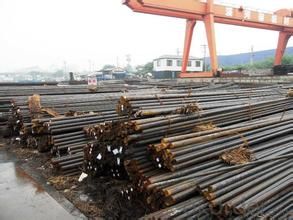
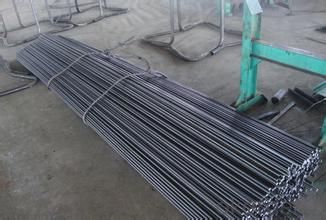
- Q: What are the quality control measures for steel round bars?
- Quality control measures for steel round bars typically involve a series of inspections and tests to ensure that the bars meet the required specifications and standards. These measures are crucial to ensure the structural integrity and reliability of the steel bars. Some common quality control measures for steel round bars include: 1. Visual Inspection: This involves a visual examination of the bars to detect any surface defects such as cracks, pits, or rust. It ensures that the bars have a smooth surface finish and are free from any visible imperfections. 2. Dimensional Inspection: This involves measuring the diameter, length, and straightness of the steel bars to ensure they meet the required tolerances. Any deviations from the specified dimensions can affect the performance and fit of the bars in various applications. 3. Chemical Composition Analysis: Steel round bars undergo chemical composition analysis to verify the percentage of various elements present in the steel. This analysis helps ensure that the bars have the correct alloying elements in the right proportions, which directly impacts their mechanical properties and performance. 4. Mechanical Testing: Various mechanical tests are performed on steel round bars to assess their strength, hardness, and other mechanical properties. These tests can include tensile testing, impact testing, and hardness testing. These tests help determine if the bars meet the required strength and durability standards. 5. Ultrasonic Testing: Ultrasonic testing is often used to detect internal defects such as voids, inclusions, or cracks in steel round bars. This non-destructive testing technique uses high-frequency sound waves to identify any flaws that may compromise the structural integrity of the bars. 6. Surface Treatment Inspection: If the steel round bars undergo any surface treatments such as heat treatment or coating, an inspection is conducted to ensure that the treatments are properly applied and meet the required specifications. 7. Certification and Documentation: Quality control measures also include proper documentation and certification of the steel round bars. This ensures traceability and provides evidence that the bars have undergone the required inspections and tests, giving customers confidence in the product's quality. Overall, these quality control measures for steel round bars help ensure that the bars are of high quality, meet the required specifications, and are suitable for their intended applications.
- Q: What are the different international standards for steel round bars?
- There are several international standards that define the specifications and requirements for steel round bars. Some of the commonly used standards include: 1. ASTM A36/A36M: This standard covers carbon structural steel shapes, plates, and bars of structural quality for use in riveted, bolted, or welded construction of bridges and buildings. It specifies the chemical composition, mechanical properties, and dimensional tolerances for steel round bars. 2. ASTM A615/A615M: This standard specifies the requirements for deformed and plain carbon-steel bars for concrete reinforcement. It covers bars with sizes ranging from 6 to 60 mm in diameter and provides guidelines for chemical composition, mechanical properties, and bend tests. 3. BS 4449: This British Standard covers steel bars for the reinforcement of concrete. It outlines the requirements for carbon steel bars in various grades, including B500B and B500C. It specifies the tensile properties, chemical composition, and dimensional tolerances for these steel round bars. 4. DIN 17100: This German standard specifies the general structural steels, including steel round bars. It provides guidelines for the chemical composition, mechanical properties, and technical delivery conditions for different grades of steel bars. 5. JIS G3101: This Japanese Industrial Standard covers general structure rolled steel for various applications. It includes steel round bars and defines the chemical composition, mechanical properties, and dimensional tolerances for different grades of steel bars. 6. ISO 6935-2: This International Organization for Standardization standard specifies the requirements for hot-rolled steel bars for the reinforcement of concrete. It provides guidelines for the chemical composition, mechanical properties, and dimensional tolerances of steel round bars used in construction. These are just a few examples of the various international standards that exist for steel round bars. It is important to consult the appropriate standard based on the specific application and requirements to ensure compliance and quality of the steel round bars used.
- Q: Are steel round bars suitable for aerospace applications?
- Yes, steel round bars are suitable for aerospace applications as they offer high strength, durability, and excellent resistance to corrosion, making them ideal for various aerospace components such as landing gear, engine parts, and structural elements.
- Q: What are the different types of steel round bar alloys?
- Some of the different types of steel round bar alloys include carbon steel, alloy steel, stainless steel, tool steel, and high-speed steel.
- Q: Can steel round bars be used in high temperature applications?
- High temperature applications can make use of steel round bars. Yet, the steel type and composition play a pivotal role in determining their appropriateness for such circumstances. Specific steel grades, like stainless steel or heat-resistant alloys, are purposefully crafted to endure high temperatures, upholding their strength and avoiding deformation. These steel round bars find applications in furnace components, boiler tubes, and heat exchangers, where they confront intense heat. To guarantee optimal performance and longevity, it is vital to carefully choose the suitable steel grade based on the application's specific temperature demands and conditions.
- Q: What is the tolerance for length in steel round bars?
- The tolerance for length in steel round bars typically depends on the specific industry standards and requirements. However, in general, the tolerance for length in steel round bars can range from +/- 1/8 inch to +/- 1/4 inch, or even tighter tolerances depending on the application and specifications outlined by the manufacturer or customer.
- Q: Can steel round bars be used for making wheel hubs?
- Indeed, wheel hubs can be crafted using steel round bars. The preference for steel round bars in the fabrication of wheel hubs is attributed to their robustness and longevity. The cylindrical form of these bars facilitates effortless machining and shaping to meet the desired wheel hub design. Steel is renowned for its remarkable tensile strength and ability to withstand deterioration, making it an optimal substance for wheel hubs that must endure substantial loads and incessant wheel rotation. Moreover, steel is easily accessible and comparatively economical in contrast to alternative materials, rendering it a favored selection in the automotive sector for wheel hub manufacturing.
- Q: What are the advantages of using free-cutting steel round bars?
- There are several advantages to using free-cutting steel round bars. Firstly, they offer improved machinability, which means they can be easily and efficiently machined into various shapes and sizes without excessive tool wear or power consumption. This leads to increased productivity and reduced manufacturing costs. Additionally, free-cutting steel round bars have excellent chip formation properties, resulting in better surface finish and dimensional accuracy of the machined parts. They also exhibit enhanced surface hardness and wear resistance, making them suitable for applications that require durability and strength. Lastly, these bars are readily available and cost-effective, making them a preferred choice for many industries.
- Q: What are the different types of corrosion-resistant steel round bars?
- There are several different types of corrosion-resistant steel round bars available in the market. Some of the commonly used types include: 1. Stainless Steel Round Bars: Stainless steel is a popular choice for corrosion-resistant applications due to its high resistance to rust and corrosion. It contains chromium, which forms a protective oxide layer on the surface of the steel, preventing further corrosion. 2. Duplex Stainless Steel Round Bars: Duplex stainless steel is a type of stainless steel that contains a balanced combination of austenite and ferrite microstructures. This gives it excellent corrosion resistance, high strength, and good weldability. 3. Nitronic Stainless Steel Round Bars: Nitronic stainless steel is a high-performance alloy that offers superior corrosion resistance, high strength, and good ductility. It contains nitrogen, which enhances its resistance to pitting and crevice corrosion. 4. Alloy Steel Round Bars: Alloy steel is a type of steel that is alloyed with various elements to improve its properties. Some alloy steels, such as corrosion-resistant alloys (CRA), are specifically designed to resist corrosion in harsh environments. These alloys typically contain elements such as chromium, nickel, and molybdenum. 5. Aluminum Round Bars: While not technically steel, aluminum round bars are often used in applications where corrosion resistance is essential. Aluminum forms a protective oxide layer on its surface, which helps prevent corrosion. It is particularly suitable for applications where weight is a concern. 6. Copper-Nickel Round Bars: Copper-nickel alloys, such as Cu-Ni 90/10 and Cu-Ni 70/30, are widely used in marine and offshore applications due to their excellent resistance to seawater corrosion. These alloys have high strength, good ductility, and exceptional resistance to biofouling. These are just a few examples of the different types of corrosion-resistant steel round bars available. The choice of material depends on the specific application requirements, environmental conditions, and budget considerations. It is important to consult with a materials engineer or specialist to select the most suitable corrosion-resistant steel round bar for a particular application.
- Q: What are the advantages of using carbon-manganese alloy steel round bars?
- Carbon-manganese alloy steel round bars offer several advantages. Firstly, they possess excellent strength and durability, making them ideal for applications requiring high mechanical properties. Additionally, the presence of manganese enhances the hardenability of the steel, allowing it to be easily heat-treated to achieve desired hardness levels. Moreover, carbon-manganese alloy steel round bars exhibit good weldability and machinability, making them versatile and easy to work with. Lastly, they provide cost advantages as they are relatively affordable compared to other high-strength steel options.
Send your message to us
Steel Round Bar Product Heat treatment of high quality steel
- Loading Port:
- Tianjin
- Payment Terms:
- TT or LC
- Min Order Qty:
- 25 m.t.
- Supply Capability:
- 7000 m.t./month
OKorder Service Pledge
OKorder Financial Service
Similar products
Hot products
Hot Searches
Related keywords
